

Rector's Address at the Funeral Eucharist for Edith Wyeth
1 April 2011 at St George-in-the-East
with illustrations from the family album
My first thought for a gospel reading for this service was the Presentation of Christ in the Temple (Luke 2.22-38), which tells of the prophet Anna - a year younger than Edith, though a widow for rather longer than Edith's 38 years in that state of life. Like Anna in the temple, Edith delighted to be in and around the church which formed a major part of her life's story, joining in prayer and worship and doing a thousand other things besides. And like Anna, Edith 'gossiped the gospel' to all around - friends, neighbours and strangers alike - telling them of all the wonderful things she had experienced through meeting Jesus here.
But
I was influenced by the fact that I only knew Edith as an old lady
(even if she was astonishingly young at heart, progressive in
attitude, and quick of mind to the end). Tricia and Jenefer's choice,
which takes us to the other end of the age range and speaks of how we
can only enter the kingdom of God by coming as little children, is
better. It reminds us that it is the whole of Edith's long and
full life, lived with a childlike (but never childish) trust in her
Saviour, that we are celebrating and commending to God in this
eucharist. So we need to tell something of the story of that life, so
that we can gather our memories and offer them to God. It's quite a
lengthy story, and of course it's bound up with the story of our
parish, and the story of her beloved East End with all its changes
and chances. There's much more that could be added by all of you
here; there'll be an opportunity to do this at a memorial service in
due course.
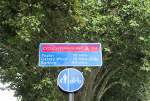 Edith
Margaret Whiting was born on St Andrew's Day, 30 November 1923. Her
father, William Thomas Whiting, worked for Lord Winterton. (The
Turnour family were local landlords and grandees, and Earl Winterton,
being an Irish peer, was able sit as a Member of Parliament; he was a
Tory minister, and later became Father of the House, sporting a
striking green eye-patch.) William Whiting's local legacy is the row
of six large London plane trees he planted in Cable Street, opposite
Hawksmoor Mews - the houses and gardens have gone, but the trees
remain, now overshadowing the lurid blue Cycle Superhighway 3.
Edith
Margaret Whiting was born on St Andrew's Day, 30 November 1923. Her
father, William Thomas Whiting, worked for Lord Winterton. (The
Turnour family were local landlords and grandees, and Earl Winterton,
being an Irish peer, was able sit as a Member of Parliament; he was a
Tory minister, and later became Father of the House, sporting a
striking green eye-patch.) William Whiting's local legacy is the row
of six large London plane trees he planted in Cable Street, opposite
Hawksmoor Mews - the houses and gardens have gone, but the trees
remain, now overshadowing the lurid blue Cycle Superhighway 3.
 Edith
was baptized here by the first in her long line of Rectors, John
Charles Beresford. The family home was at 33 Walburgh Street (between
what are now Chapman and Bigland Streets - here is a picture of the 1945 peace party in the street, showing the bomb damage). She attended church with
her parents and brother George (whose daughters Rosemary and Barbara are here today). [family picture at Ramsgate - Edith on the left]. In due course she joined the Guides. Rector
Beresford was a keen music educator; he founded the Stepney Orpheus
Choir, which won all the prizes, but ran several other choirs in the
parish, including a Guides choir; perhaps it was here that Edith
learnt to hold down the alto line in hymns, something she loved to do
right up to the end (there is her hymnbook.) Her primary school was
Sir John Cass, in the City, from where she went across the river to
St Saviour & St Olave's Grammar School for Girls - and was proud
to be a pupil of both. Had times been different I'm sure she would
have gone on to higher education, but as for so many of her
generation that opportunity was denied her.
Edith
was baptized here by the first in her long line of Rectors, John
Charles Beresford. The family home was at 33 Walburgh Street (between
what are now Chapman and Bigland Streets - here is a picture of the 1945 peace party in the street, showing the bomb damage). She attended church with
her parents and brother George (whose daughters Rosemary and Barbara are here today). [family picture at Ramsgate - Edith on the left]. In due course she joined the Guides. Rector
Beresford was a keen music educator; he founded the Stepney Orpheus
Choir, which won all the prizes, but ran several other choirs in the
parish, including a Guides choir; perhaps it was here that Edith
learnt to hold down the alto line in hymns, something she loved to do
right up to the end (there is her hymnbook.) Her primary school was
Sir John Cass, in the City, from where she went across the river to
St Saviour & St Olave's Grammar School for Girls - and was proud
to be a pupil of both. Had times been different I'm sure she would
have gone on to higher education, but as for so many of her
generation that opportunity was denied her.
In late 1937, or maybe 1938 (now with Rector no 2, Bruce Eadie) a Miss Marjory Wyeth, from Ashingdon in Essex, became the latest in the line of women workers appointed to the parish, and was Guide Captain. On one occasion her younger brother Jimmy came to visit. They say that Edith and Jimmy were given the winning tape to hold at Guide Sports but were so intent on gazing at each other that they didn't notice who won the race.
Then came the war. Just before the declaration, her school was evacuated to Hove. (By coincidence, her youngest grand-daughter Anna now lives a few streets away and managed to identify the house where her nan stayed; after Nora Solomon's funeral some of us went to have a look at it.) Like many of the early evacuees, Edith returned to London the following summer - her parents were missing her. Aged 16, she went to work at Lloyd's Bank in the West End and sometimes used to walk all the way there, often sleeping overnight in the bank vault or air raid shelters. As with many who lived through the war, she was reluctant to talk about it.
In 1941 Edith experienced the first of what I reckon to be over 700 PCC meetings, as one of two Guides invited to attend. Curiously, the experience does not seem to have put her off. Ten days later, on 16 April, Christ Church Watney Street was destroyed by a landmine, and the following month St George-in-the-East was blitzed. Enter Rector 3, John Groser, who took charge of what was left of the parishes, holding worship in the Rectory, the mission hall and then the prefab that became St George-in-the-Ruins.
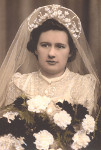 The
government announced that women without families to look after would
be called up to join the Land Army; so her dad agreed that Edith, now
aged 19, could marry Jimmy, who was serving with the RAF. They
married on 13 March 1943: it's in our parish registers, but like most
weddings in that period, it took place at St Paul Shadwell. Edith's
schoolfriend Mary married the curate, Denys Giddey, a few years
later: his son Simon will join us tomorrow.
The
government announced that women without families to look after would
be called up to join the Land Army; so her dad agreed that Edith, now
aged 19, could marry Jimmy, who was serving with the RAF. They
married on 13 March 1943: it's in our parish registers, but like most
weddings in that period, it took place at St Paul Shadwell. Edith's
schoolfriend Mary married the curate, Denys Giddey, a few years
later: his son Simon will join us tomorrow.
It was hard to find people to serve on the PCC in those dark years, so although she was under age she was co-opted in 1944, and the following April was elected churchwarden at the youngest possible age of 21, together with Miss King. At a time when wardens were generally elderly men, this was a sign that St George-in-the-East has always been at heart a progressive parish.
She found Fr Groser an inspiring priest - she said that through him the Christian faith came alive for her, as she came to understand the social implications of the gospel, and the claims of justice. She signed up as a Christian Socialist (so it's good that today, as well as being April Fools' Day [which she'd have liked], is also the day when the Church of England remembers Frederick Denison Maurice). These were the days when they sang that hymn with the verse God is the only landlord to whom our rents are due (so much for her father's employer...), and when Fr Groser broke into a food store to give East Enders access to supplies they desperately needed (see Ken Leech for more detail on this and much else). Last week some of us reflected on Fr Groser's later ministry at the Royal Foundation of St Katharine when its patron the Queen visited. Edith herself was no stranger to royalty (or do I mean vice versa?): in her time she welcomed the Queen Mother, Princess Margaret and Prince Charles to the parish, as pictures in her flat testify.
When Jimmy was demobbed, they took up residence on the top floor of the Mission Hall, 181 The Highway - with Marjory on the floor below (later known to the family as Aunty Bunny; she married Fred the thin organist, and took him back to Ashingdon - where Edith's ashes will in due course be laid to rest in the family plot). Marjory was succeeded here as parish worker by Dorothy Halsall, Ethel Upton and later Morwenna Tredinnick (two of whom lived into their 90s, and I think are represented here tonight).
 In this flat
Tricia and Jenefer began their days - getting the pram up the stairs
must have been a struggle. They were both baptized here, as in due
course were Tricia's daughters Helen and Lizzie, with christening
parties in the Rectory garden of which Jimmy was so proud (and in
which in her later years Edith sat for many a long hour by the roses
he planted, reading, and sometimes dozing.) When Tricia was born
Edith stood down as churchwarden for all of five months, handing over
to her father, but she was soon back in harness. Even with two young
children she took a leading role in organising fairs and fêtes (much
grander events than they are today), and jumble sales (which she
always loved, having as we know a keen eye for a bargain, and never
willing to let anything go to waste).
In this flat
Tricia and Jenefer began their days - getting the pram up the stairs
must have been a struggle. They were both baptized here, as in due
course were Tricia's daughters Helen and Lizzie, with christening
parties in the Rectory garden of which Jimmy was so proud (and in
which in her later years Edith sat for many a long hour by the roses
he planted, reading, and sometimes dozing.) When Tricia was born
Edith stood down as churchwarden for all of five months, handing over
to her father, but she was soon back in harness. Even with two young
children she took a leading role in organising fairs and fêtes (much
grander events than they are today), and jumble sales (which she
always loved, having as we know a keen eye for a bargain, and never
willing to let anything go to waste).
Rector no 4, Jack Boggis (formerly Fr Groser's curate), continued the Christian Socialist tradition. Edith remained in close contact with the family ever after. His widow Lotte is approaching her centenary - the girls remember her German-style teas in the Rectory, not to mention German-style floor-polishing - and Edith's god-daughter Celia will be with us tomorrow.
From 1958-65 Jimmy joined Edith as fellow-churchwarden, and they worked with Rector no 6, Alex Solomon, on his imaginative plans for restoring the church. (You'll notice that we've passed over Rector no 5 - he was a former Conservative councillor who disappeared rather suddenly during a jumble sale - one of the many incidents of which Edith knew the inside story, but recounted with discretion, and no malice.) So Arthur Bailey's rebuild came to pass, and Edith and Jimmy's names are carved into the stone of the fabric in the porch, and inscribed on one of the new ring of bells. By then the Mission Hall had been demolished, so the family moved into the Rectory - again the top floor, where Edith was to live for the next 33 years until the Rectory flat was created for her, and befriended the succession of residents on the other floors and church flats (including, to name but two, the economist and theologian Denys Munby, and Alan Shadwick of the Church Times).
In 1967 Jimmy became Treasurer, and when he died in 1973 Edith took on this additional role for some time. So began the sequence of little boxes of carefully-accounted money that still fill the church safe. There was also the magazine to print and distribute. Yet her real passion was always for activities involving people - this is what made her come alive: she hated being alone, and always loved entertaining clergy and others who were in need of a good square meal. She enjoyed English country dancing (shades of Thaxted), and helped to run the junior choir and youth clubs - including holidays, with the curate Christopher Bird (now deceased) and Pam and Eric Maurice (whose son is now Bishop of Taunton) - yet another family with whom she kept in touch down the years. What a great witness she has been through her life, writes Bishop Peter.
In the 1970s we took on responsibility for St Paul Dock Street (and with it acquired our church school, of which more in a moment); 'St George-in-the-East with Christ Church and St John' was becoming 'St George-in-the-East with St Paul'. This was to give Edith, her fellow-warden Betty Still, and Olive Wagstaff many a headache, dealing with Fr Aquinas who drove round in an untaxed van (though he had never passed a driving test) and housed lodgers in the tower. From Edith and Olive's account, the Archdeacon could have been the role model for the one in Rev.
Rector no 7 Julian Scharf was shared with the other St Paul's, St Paul Shadwell - this was one of several pastoral rethinks that Edith sat through in her time. The still-remembered Auschwitz exhibition was held in the crypt hall, and drama and music and memorable parish events were also there (Leo Aylen's presence here is a reminder of this period) - but she lived to see, and support, the conversion of the crypt into a nursery school and the base for NTMTC.
I had best remain silent over Rectors 8, 9 and 10 - Gillean Craig, John Cullen (technically priest-in-charge), and myself - for we are all here tonight. Suffice it to say that, though we are very different, Edith worked enthusiastically and loyally with all of us. I remember the formal interview she and Susan Crocker arranged when I was appointed, sitting around the table in the panelled room where she had seen it all happen, and where her body will lie overnight. In the kindest possible way, she fixed me with those sharp eyes that never missed a trick as she put me through my paces.
Let me remind you of Canon E1.4: The churchwardens....shall discharge such duties as are by law and custom assigned to them; they shall be foremost in representing the laity and in co-operating with the incumbent; they shall use their best endeavours by example and precept to encourage the parishioners in the practice of true religion and to promote unity and peace among them. They shall also maintain order and decency in the church and churchyard, especially during the time of divine service.
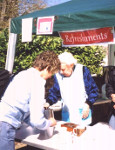 Unlike her
Victorian predecessors here, Edith never had to use her stave to ward
off ritualism rioters, but otherwise she did exactly what it says on
the tin, plus much more (including a long stint on Deanery Synod - or
Ruri-Decanal Conference as it was when she started). And she did it
for - how long? When she finally stood down two years ago, we said it
was over fifty years, but the true figure turns out to be 64 years
(less that 5-month sabbatical). This is somewhat in excess of what
the current Churchwarden's Measure envisages. A member of the
congregation has commented One hears of wardens who continue,
shall we say, long beyond their ‘best before date’. Well Edith
was not one of those, and even when she had health problems of her
own to contend with, there was never any danger of Edith becoming a
health risk to St Georges! I suspect we owe her more than any of us
will really ever know. And he adds If it was down to willpower
alone, I have no doubt she would have been with us for years to come;
she has certainly been a source of strength to many generations of St
George's people. Phrases that others have used include a
positive can-do, forward looking attitude... a welcoming approach -
for the congregation, for the many visitors to the church, and
even to those she dealt with as on-site parking attendant.
Unlike her
Victorian predecessors here, Edith never had to use her stave to ward
off ritualism rioters, but otherwise she did exactly what it says on
the tin, plus much more (including a long stint on Deanery Synod - or
Ruri-Decanal Conference as it was when she started). And she did it
for - how long? When she finally stood down two years ago, we said it
was over fifty years, but the true figure turns out to be 64 years
(less that 5-month sabbatical). This is somewhat in excess of what
the current Churchwarden's Measure envisages. A member of the
congregation has commented One hears of wardens who continue,
shall we say, long beyond their ‘best before date’. Well Edith
was not one of those, and even when she had health problems of her
own to contend with, there was never any danger of Edith becoming a
health risk to St Georges! I suspect we owe her more than any of us
will really ever know. And he adds If it was down to willpower
alone, I have no doubt she would have been with us for years to come;
she has certainly been a source of strength to many generations of St
George's people. Phrases that others have used include a
positive can-do, forward looking attitude... a welcoming approach -
for the congregation, for the many visitors to the church, and
even to those she dealt with as on-site parking attendant.
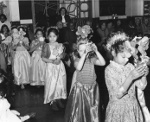
 But lest you think
that church life occupied every waking moment, remember that for many
years Edith managed to find time to go out to work - as secretary and
occasional teacher at Harry Gosling School, from 1957 until she
retired at the age of 68 [right: staff picture 1960; school event, with Fr Solomon in the audience]. Myrtle Hurrell, headteacher from 1972, is
here today, and some of her memories are posted on the blog of former
pupil, now schools adviser, journalist and footballer, Emdad Rahman (also present),
together with some affectionate comments of his own: see here. She represented the non-teaching staff on the governors, and then
later was a governor in her own right until 2002. When she started,
many of the children were Jewish, and then, as the area changed,
Muslim. So Edith knew her neighbours' faiths and and foods and
customs from the inside, as she befriended the children and their
families, a number of whom we welcome tonight. You still down the
church? they asked in the street. Miss, I remember you from
school. This experience gave her a generous and inclusive
approach to inter-faith relationships.
But lest you think
that church life occupied every waking moment, remember that for many
years Edith managed to find time to go out to work - as secretary and
occasional teacher at Harry Gosling School, from 1957 until she
retired at the age of 68 [right: staff picture 1960; school event, with Fr Solomon in the audience]. Myrtle Hurrell, headteacher from 1972, is
here today, and some of her memories are posted on the blog of former
pupil, now schools adviser, journalist and footballer, Emdad Rahman (also present),
together with some affectionate comments of his own: see here. She represented the non-teaching staff on the governors, and then
later was a governor in her own right until 2002. When she started,
many of the children were Jewish, and then, as the area changed,
Muslim. So Edith knew her neighbours' faiths and and foods and
customs from the inside, as she befriended the children and their
families, a number of whom we welcome tonight. You still down the
church? they asked in the street. Miss, I remember you from
school. This experience gave her a generous and inclusive
approach to inter-faith relationships.
In the 1980s she also became a governor at St Paul's School in Wellclose Square, and chair during the various vacancies, so she came to know the ins and outs of running a voluntary aided school. Terry Bennett, the head, says she was a good and loyal friend of the school through thick and thin, and her fellow-governors have paid tribute to her acumen right up to the end of her life (she was still in post when she died).
For all of this, in 2007 Bishop Richard made Edith a member of the Order of St Mellitus - a personal and diocesan recognition of lifetime service to church and community. (In fact there were plans to nominate Edith for a national honour, and had she survived to Mothering Sunday the family had planned to break the rules and show her all the letters and testimonials that had been gathered. But they do not now face a spell in the Tower.)
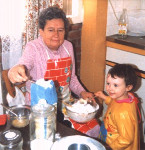 Edith was proud of
her family and their achievements, and shared their disappointments.
She took delight in Tricia's amateur dramatics, and in the arrival of
Helen's daughter Hannah (her only great-grand-daughter); she worried
about Lizzie's health. Across the river were Jenefer and Tony, and
she followed Ruth and Anna's progress keenly. When Ruth and Jason
went to Canada for the winter a few years ago she thought she might
not survive until her return - she needn't have worried! Nearer at
home in later years were the various clubs she attended. Until her
last months, the D3, the 100, the DLR and walking through the streets
at night held no terrors for her.
Edith was proud of
her family and their achievements, and shared their disappointments.
She took delight in Tricia's amateur dramatics, and in the arrival of
Helen's daughter Hannah (her only great-grand-daughter); she worried
about Lizzie's health. Across the river were Jenefer and Tony, and
she followed Ruth and Anna's progress keenly. When Ruth and Jason
went to Canada for the winter a few years ago she thought she might
not survive until her return - she needn't have worried! Nearer at
home in later years were the various clubs she attended. Until her
last months, the D3, the 100, the DLR and walking through the streets
at night held no terrors for her.
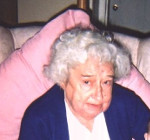 Nor did poor
health ever stop her. Edith had rheumatic or scarlet fever as a
child, and suffered with heart and lung problems most of her life.
Hannah says I will miss Grandma - she was so good at playing
hospitals - well, this is because she knew them inside out. She
died as she had lived - surrounded by those she loved, continuing to
befriend the hospital staff, and apologising for being a nuisance.
The last scripture she heard read, at her bedside, was our New
Testament reading with its promise of a new creation - a new heaven
and a new earth (where we may hope PCCs will be no more). What a
woman, said one local priest's email; a great woman of God,
said another. Yes, but above all a child
of God, one who knew his love and care for her in Christ and shared
that love and care with others. It is to such as these that the
kingdom of God belongs - to those who never lose their simplicity of
heart.
Nor did poor
health ever stop her. Edith had rheumatic or scarlet fever as a
child, and suffered with heart and lung problems most of her life.
Hannah says I will miss Grandma - she was so good at playing
hospitals - well, this is because she knew them inside out. She
died as she had lived - surrounded by those she loved, continuing to
befriend the hospital staff, and apologising for being a nuisance.
The last scripture she heard read, at her bedside, was our New
Testament reading with its promise of a new creation - a new heaven
and a new earth (where we may hope PCCs will be no more). What a
woman, said one local priest's email; a great woman of God,
said another. Yes, but above all a child
of God, one who knew his love and care for her in Christ and shared
that love and care with others. It is to such as these that the
kingdom of God belongs - to those who never lose their simplicity of
heart.
May her portion this day be in peace, and her dwelling in the heavenly Jerusalem.